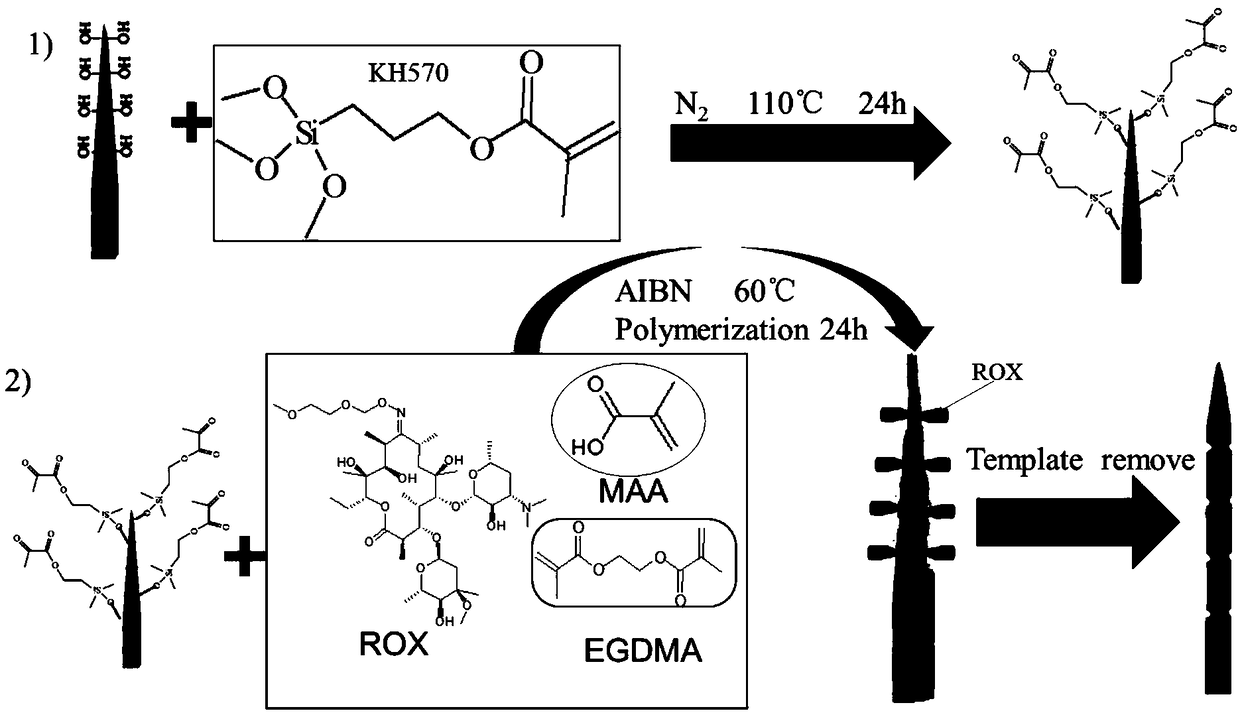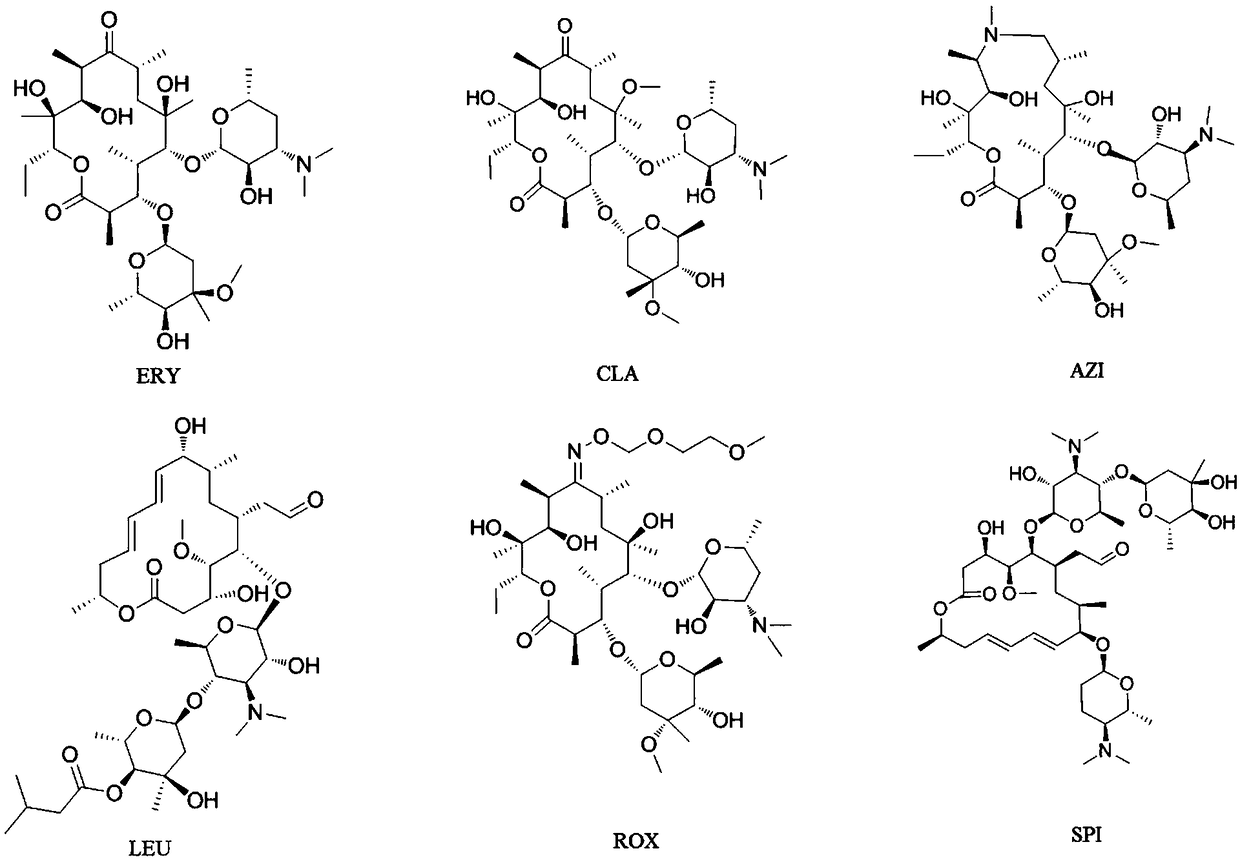Macrolide antibiotic high-selectivity solid-phase micro-extraction probe, preparation method thereof and application of probe
A macrolide, high-selectivity technology, applied in the field of chemistry, can solve the problems of low UV response of macrolide antibiotics, restricting the speed of analysis and detection, and difficult to meet detection requirements, and achieves selectivity and enrichment. Strong ability, good linearity, good linearity effect
- Summary
- Abstract
- Description
- Claims
- Application Information
AI Technical Summary
Problems solved by technology
Method used
Image
Examples
Embodiment 1
[0035] 1. Preparation of solid-phase microextraction probes
[0036] figure 1The basic process of making the solid-phase microextraction probe is shown. First cut the wooden stick (birch toothpick) into a length of about 2 cm, and then use a knife to further cut the tip of the wooden stick into a thinner tip (0.1-0.2 mm in outer diameter) to make a solid-phase microextraction probe. Solid substrate for needles. Then, put the wooden stick in a double-necked flask, add 100mL of N,N-dimethylformamide (DMF), and then add 5mL of coupling reagent γ-methacryloxypropyltrimethoxysilane (MPS) Reagents, protected by nitrogen, heated to 110 ° C, stirred and refluxed for 24 hours. After the reaction, wash with absolute ethanol to remove unreacted MPS, and dry naturally to obtain a surface-modified vinyl wooden stick.
[0037] Weigh 0.005 mmol of template molecule roxithromycin in 10 mL of acetonitrile, dissolve it by ultrasonic, add 1 mmol of methacrylic acid (Methacrylic acid, MAA) as...
Embodiment 2
[0060] 1. Preparation of solid-phase microextraction probe (with bamboo stick as solid matrix)
[0061] First cut the bamboo stick (bamboo toothpick), and then use a knife to further cut the tip of the bamboo stick into a thinner one) to make the solid matrix of the solid-phase microextraction probe. Then, put the bamboo stick in a double-necked flask, add 100mL of toluene, then add 2mL of coupling reagent γ-methacryloxypropyltrimethoxysilane (MPS) reagent, protect with nitrogen, heat to 100°C and stir Reflux reaction 20h. After the reaction was finished, it was washed with absolute ethanol to remove unreacted MPS, and the surface-modified vinyl bamboo sticks were obtained by natural drying.
[0062] Weigh 0.001mmol of the template molecule roxithromycin in 10mL of acetonitrile, dissolve it by ultrasonic, add 2mmol of methacrylic acid (Methacrylic acid, MAA) as a functional monomer, and pre-polymerize at room temperature overnight; put bamboo sticks into the mixed solution A...
Embodiment 3
[0069] 1. Preparation of solid-phase microextraction probe (wooden stick as solid substrate)
[0070]First cut the wooden stick (birch toothpick) into a length of about 2 cm, and then use a knife to further cut the tip of the wooden stick into a thinner tip (0.1-0.2 mm in outer diameter) to make a solid-phase microextraction probe. Solid substrate for needles. Then, put the wooden stick in a double-necked flask, add 100mL of dichloromethane, then add 4mL of coupling reagent γ-methacryloxypropyltrimethoxysilane (MPS) reagent, nitrogen protection, heat to 120 °C stirring and reflux reaction for 12h. After the reaction, wash with absolute ethanol to remove unreacted MPS, and dry naturally to obtain a surface-modified vinyl wooden stick.
[0071] Weigh 0.003mmol of the template molecule roxithromycin in 15mL of acetonitrile. After ultrasonically dissolving, add 2mmol of methacrylic acid (Methacrylic acid, MAA) as a functional monomer, pre-polymerize at room temperature overnight...
PUM
| Property | Measurement | Unit |
|---|---|---|
| diameter | aaaaa | aaaaa |
Abstract
Description
Claims
Application Information
 Login to View More
Login to View More - R&D
- Intellectual Property
- Life Sciences
- Materials
- Tech Scout
- Unparalleled Data Quality
- Higher Quality Content
- 60% Fewer Hallucinations
Browse by: Latest US Patents, China's latest patents, Technical Efficacy Thesaurus, Application Domain, Technology Topic, Popular Technical Reports.
© 2025 PatSnap. All rights reserved.Legal|Privacy policy|Modern Slavery Act Transparency Statement|Sitemap|About US| Contact US: help@patsnap.com



